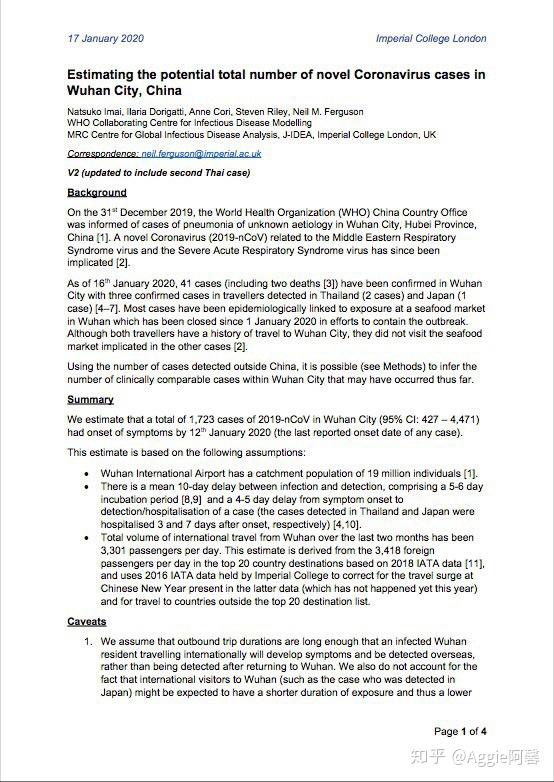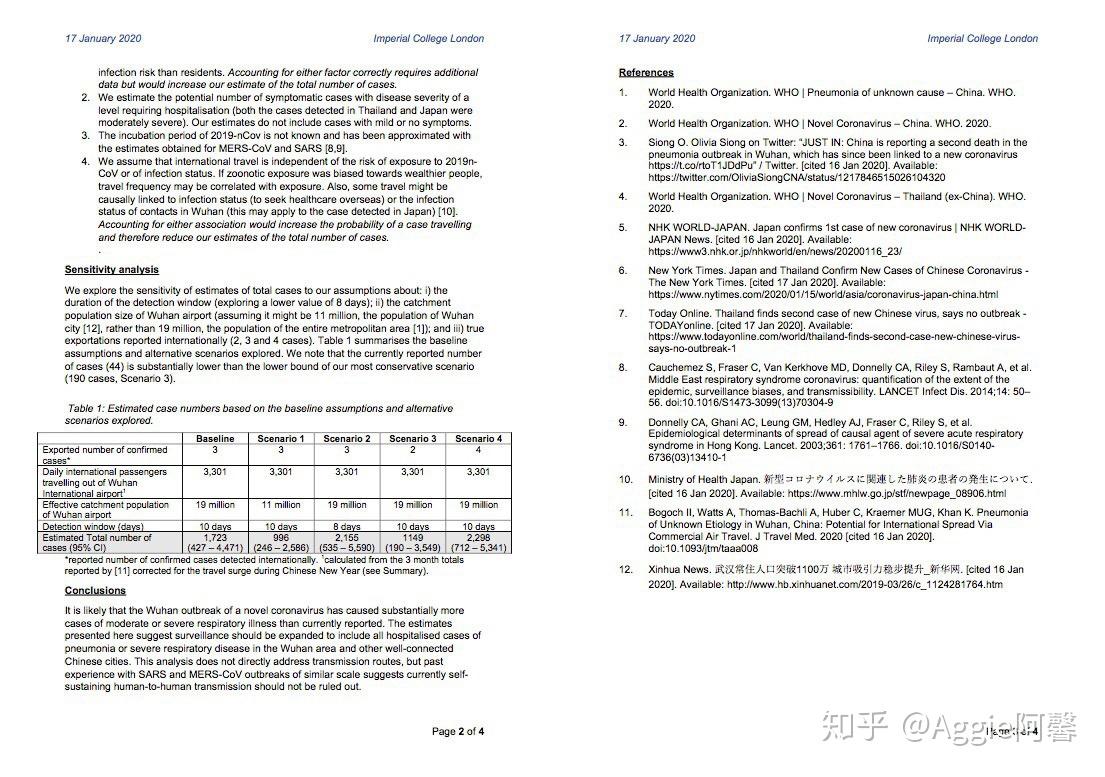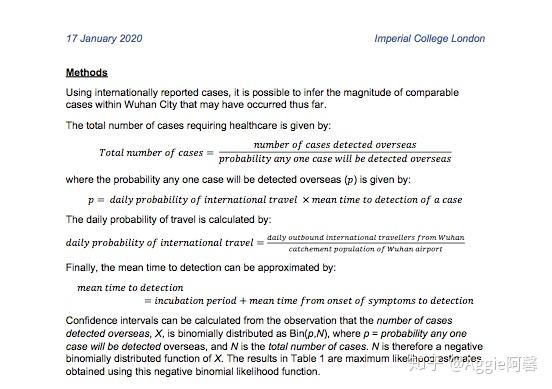|
|
 发表于 2020-1-23 12:36:24
|
显示全部楼层
发表于 2020-1-23 12:36:24
|
显示全部楼层
来自: 中国辽宁沈阳
来搬运一下外国专家在感染者人数上所做的研究,注意次数据并不代表官方确定数据!
关于此文的申明:
· 本报告的翻译并非出自专业人事,但在内容方面与原版相比较足以概括出其所要传达的核心信息及结论。
· 由于时间原因,本文指争对核心信息进行翻译,与报告中其他未进行翻译的信息同等重要,请自行综合分析。
· 此篇文章为科普性文章,目的在于警醒还在沉睡的人和告诫装睡的人。请勿用于其他用途或对原文内容进行曲解!否则后果自负。
英国伦敦帝国学院关于2019 武汉市新型流感的病例的估计报告
报告时间:2020年1月17日
 Estimating the potential total number of novelCoronavirus cases in Wuhan City, China Estimating the potential total number of novelCoronavirus cases in Wuhan City, China
中国武汉罹患新型流感病证的潜在人口数量估计
Natsuko Imai, Ilaria Dorigatti, Anne Cori, Steven Riley,Neil M. Ferguson
WHO Collaborating Centre for Infectious Disease Modelling
MRC Centre for Global Infectious Disease Analysis,J-IDEA, Imperial College London, UK
Correspondence: neil.ferguson@imperial.ac.uk V2 (updatedto include second Thai case)
Background
背景
On the 31st December 2019, the World Health Organization(WHO) China Country Office was informed of cases of pneumonia of unknownaetiology in Wuhan City, Hubei Province, China [1]. A novel Coronavirus(2019-nCoV) related to the Middle Eastern Respiratory Syndrome virus and theSevere Acute Respiratory Syndrome virus has since been implicated [2].
2019年12月31日,世界健康组织(WHO)中国办公室被告知在湖北武汉发现不知起因的肺炎病例。
As of 16th January 2020, 41 cases (including two deaths[3]) have been confirmed in Wuhan City with three confirmed cases in travellersdetected in Thailand (2 cases) and Japan (1 case) [4–7]. Most cases have beenepidemiologically linked to exposure at a seafood market in Wuhan which hasbeen closed since 1 January 2020 in efforts to contain the outbreak. Althoughboth travellers have a history of travel to Wuhan City, they did not visit theseafood market implicated in the other cases [2].
Using the number of cases detected outside China, it ispossible (see Methods) to infer the number of clinically comparable caseswithin Wuhan City that may have occurred thus far.
自从2020年1月16日起,41个病例(其中包括两个死亡病例)已被证实出现在武汉市,同时其他3个被证实的患病者中,两例通过长途旅行至台湾,一例至日本。从流行病学角度来看,大部分感染者的罹患途径与武汉一海鲜市场有关。为了限制疾病爆发,这一海鲜市场已于2020年1月1日被关闭。虽然其中的两个病患曾有在武汉有旅行的经历,但他们并没有接触过海鲜市场。通过分析在中国以外发现的患病者数量,可以推测出迄今为止武汉市此类病例的潜在总数。
Summary
概要
We estimate that a total of 1,723 cases of 2019-nCoV inWuhan City (95% CI: 427 – 4,471) had onset of symptoms by 12th January 2020(the last reported onset date of any case).
据我们估计,自2020年1月12日起已有1,723 例2019-nCoV患者出现自武汉。
This estimate is based on the following assumptions:
此次估算基于以下假设:
• Wuhan International Airport has a catchment populationof 19 million individuals [1].
武汉国际机场的流域人口为1900万
• There is a mean 10-day delay between infection anddetection, comprising a 5-6 day
incubation period [8,9] and a 4-5 day delay from symptomonset to detection/hospitalisation of a case (the cases detected in Thailandand Japan were hospitalised 3 and 7 days after onset, respectively) [4,10].
从被感染到被发现有平均10天时间,其中包括5-6天的疾病潜伏期和4-5天
的从出现症状起至接受治疗的延迟期(在台湾和日本被发现的病患入院治疗时间分别为自症状出现之日起的3天和7天)
• Total volume of international travel from Wuhan overthe last two months has been 3,301 passengers per day. This estimate is derivedfrom the 3,418 foreign passengers per day in the top 20 country destinationsbased on 2018 IATA data [11], and uses 2016 IATA data held by Imperial Collegeto correct for the travel surge at Chinese New Year present in the latter data(which has not happened yet this year) and for travel to countries outside thetop 20 destination list.
过去两个月内从武汉出发的国际旅客数为每天3301人。这项估算出自2018 IATA(国际航空运输协会)发布的数据,即2018年20个热门旅行目的地国家每天总计到达旅客数为3418人,并且帝国理工大学使用了2016年的IATA 数据来修正将会在不久之后中国春运时期的旅客激增对这一数据的影响(这一激增现在还未到来)和旅行至国外20个热门目的国的数据。
Caveats
1. We assume that outbound trip durations are long enoughthat an infected Wuhan resident travelling internationally will developsymptoms and be detected overseas, rather than being detected after returningto Wuhan. We also do not account for the fact that international visitors toWuhan (such as the case who was detected in Japan) might be expected to have ashorter duration of exposure and thus a lower
infection risk than residents. Accounting for eitherfactor correctly requires additional
data but would increase our estimate of the total numberof cases.
2. We estimate the potential number of symptomatic caseswith disease severity of a level requiring hospitalisation (both the casesdetected in Thailand and Japan were moderately severe). Our estimates do notinclude cases with mild or no symptoms.
3. The incubation period of 2019-nCov is not known andhas been approximated with the estimates obtained for MERS-CoV and SARS [8,9].
4. We assume that international travel is independent ofthe risk of exposure to 2019n- CoV or of infection status. If zoonotic exposurewas biased towards wealthier people, travel frequency may be correlated withexposure. Also, some travel might be causally linked to infection status (toseek healthcare overseas) or the infection status of contacts in Wuhan (thismay apply to the case detected in Japan) [10]. Accounting for eitherassociation would increase the probability of a case travelling and thereforereduce our estimates of the total number of cases.
Sensitivity analysis
We explore the sensitivity of estimates of total cases toour assumptions about: i) the duration of the detection window (exploring alower value of 8 days); ii) the catchment population size of Wuhan airport(assuming it might be 11 million, the population of Wuhan city [12], ratherthan 19 million, the population of the entire metropolitan area [1]); and iii)true exportations reported internationally (2, 3 and 4 cases). Table 1summarises the baseline assumptions and alternative scenarios explored. We notethat the currently reported number of cases (44) is substantially lower thanthe lower bound of our most conservative scenario (190 cases, Scenario 3).
Table 1: Estimated case numbers based on the baselineassumptions and alternative

 *reported number of confirmed cases detectedinternationally. 1calculated from the 3 month totals reported by [11] correctedfor the travel surge during Chinese New Year (see Summary). *reported number of confirmed cases detectedinternationally. 1calculated from the 3 month totals reported by [11] correctedfor the travel surge during Chinese New Year (see Summary).
Conclusions
结论
It is likely that the Wuhan outbreak of a novelcoronavirus has caused substantially more cases of moderate or severerespiratory illness than currently reported. The estimates presented heresuggest surveillance should be expanded to include all hospitalised cases ofpneumonia or severe respiratory disease in the Wuhan area and otherwell-connected Chinese cities. This analysis does not directly addresstransmission routes, but past experience with SARS and MERS-CoV outbreaks ofsimilar scale suggests currently self- sustaining human-to-human transmissionshould not be ruled out.
武汉新型流感的爆发很有可能已经造成了比目前报道的更加严重的剧烈程度不等的呼吸系统疾病。这项估算已表明,有关机构应该扩大监控范围,将所有在武汉范围内和在其他相关城市内接受治疗的肺炎病例或出现严重呼吸系统疾病的患者包括在内。这项分析并没有直接指出病毒的传播路径,但是过往SARS和MERS-CoV的爆发与这次疫情规模十分相似,这意味着病毒的可自身维系的人人传播途径不能被排除。
References
1. World Health Organization. WHO | Pneumonia of unknowncause – China. WHO. 2020.
2. World Health Organization. WHO | Novel Coronavirus –China. WHO. 2020.
3. Siong O. Olivia Siong on Twitter: “JUST IN: China isreporting a second death in the pneumonia outbreak in Wuhan, which has sincebeen linked to a new coronavirus https://t.co/rtoT1JDdPu” / Twitter. [cited 16Jan 2020]. Available:https://twitter.com/OliviaSiongCNA/status/1217846515026104320
4. World Health Organization. WHO | Novel Coronavirus –Thailand (ex-China). WHO. 2020.
5. NHK WORLD-JAPAN. Japan confirms 1st case of newcoronavirus | NHK WORLD- JAPAN News. [cited 16 Jan 2020]. Available:https://www3.nhk.or.jp/nhkworld/en/news/20200116_23/
6. New York Times. Japan and Thailand Confirm New Casesof Chinese Coronavirus - The New York Times. [cited 17 Jan 2020]. Available:https://www.nytimes.com/2020/01/15/world/asia/coronavirus-japan-china.html
7. Today Online. Thailand finds second case of newChinese virus, says no outbreak - TODAYonline. [cited 17 Jan 2020]. Available:https://www.todayonline.com/world/thailand-finds-second-case-new-chinese-virus-says-no-outbreak-1
8. Cauchemez S, Fraser C, Van Kerkhove MD, Donnelly CA,Riley S, Rambaut A, et al. Middle East respiratory syndrome coronavirus: quantificationof the extent of the epidemic, surveillance biases, and transmissibility.LANCET Infect Dis. 2014;14: 50– 56. doi:10.1016/S1473-3099(13)70304-9
9. Donnelly CA, Ghani AC, Leung GM, Hedley AJ, Fraser C,Riley S, et al. Epidemiological determinants of spread of causal agent ofsevere acute respiratory syndrome in Hong Kong. Lancet. 2003;361: 1761–1766.doi:10.1016/S0140- 6736(03)13410-1
10. Ministry of Health Japan. 新型コロナウイルスに関連した肺炎の患者の発生について. [cited 16 Jan2020]. Available: https://www.mhlw.go.jp/stf/newpage_08906.html
11. Bogoch II, Watts A, Thomas-Bachli A, Huber C, KraemerMUG, Khan K. Pneumonia of Unknown Etiology in Wuhan, China: Potential forInternational Spread Via Commercial Air Travel. J Travel Med. 2020 [cited 16Jan 2020]. doi:10.1093/jtm/taaa008
12. Xinhua News. 武汉常住人口突破1100万城市吸引力稳步提升_新华网. [cited 16 Jan 2020]. Available:http://www.hb.xinhuanet.com/2019-03/26/c_1124281764.htm |
|